1994 CHEVROLET CAVALIER tires
[x] Cancel search: tiresPage 184 of 243
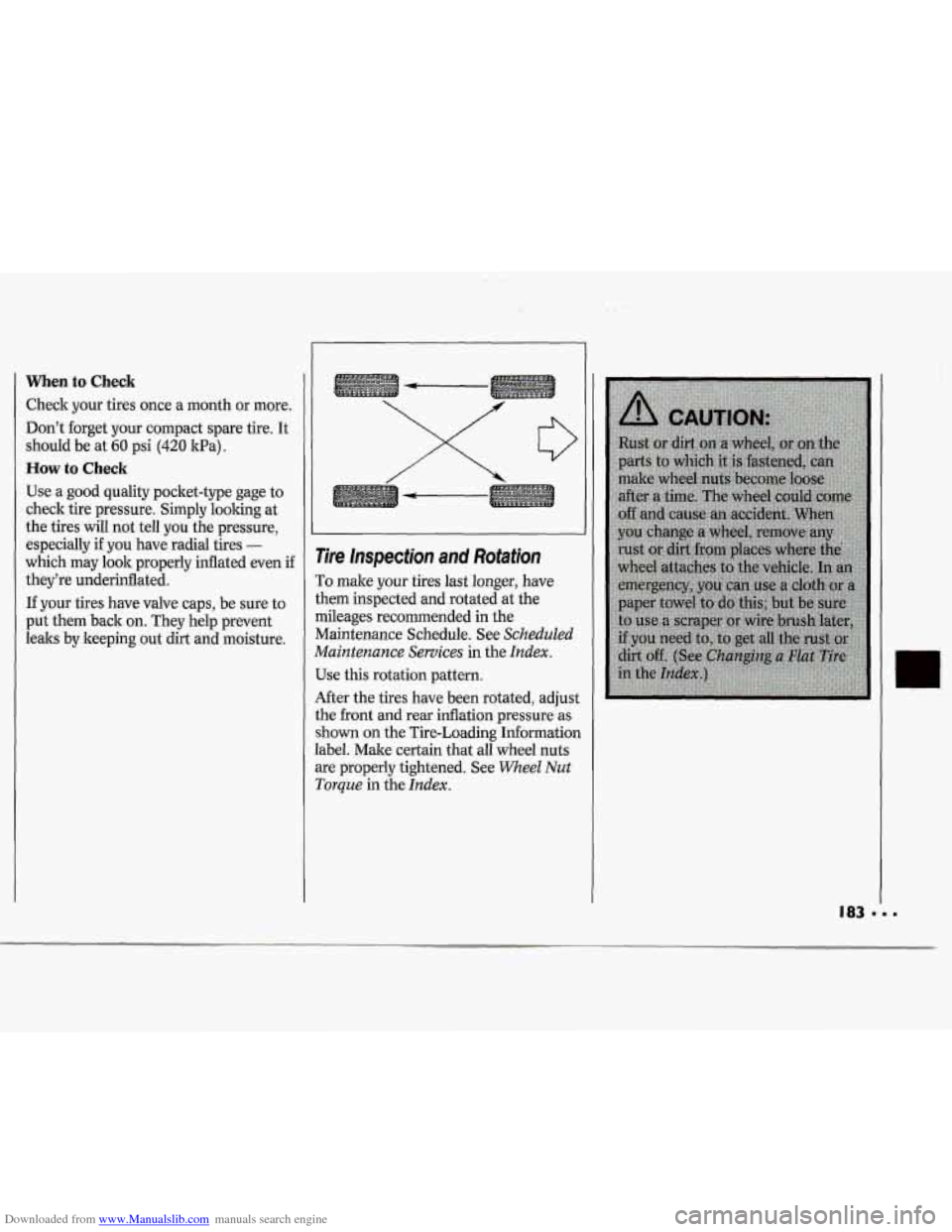
Downloaded from www.Manualslib.com manuals search engine When to Check
Check your tires once a month or more.
Don't forget your compact spare tire. It
should be at
60 psi (420 1tPa).
How to Check
Use a good quality pocket-type gage to
check tire pressure. Simply looking at
the tires
will not tell you the pressure,
especially if you have radial tires
-
which may look properly inflated even if
they're underinflated.
If your tires have valve caps, be sure to
put them back on. They help prevent
leaks by keeping out dirt and moisture.
x
Tire lnspection and Rotation
To make your tires last longer, have
them inspected and rotated at the
mileages recommended in the
Maintenance Schedule. See
Scheduled
Maintenance Services
in the Index.
Use this rotation pattern.
After the tires have been rotated, adjust
the front and rear inflation pressure as
shown on the Tire-Loading Information
label. Make certain that all wheel nuts
are properly tightened. See
Wheel Nut
Torque in the Index.
Page 185 of 243
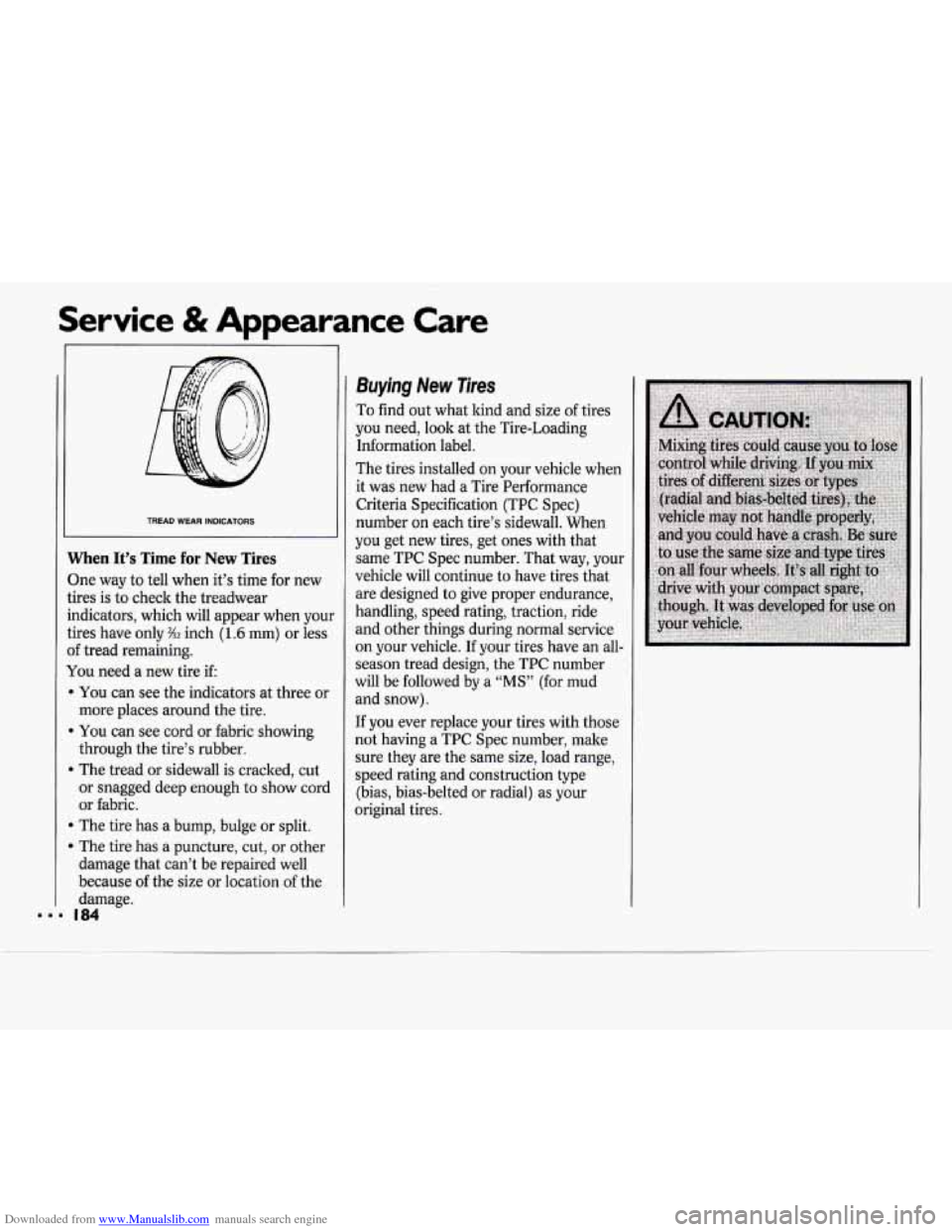
Downloaded from www.Manualslib.com manuals search engine Service & Appearance Care
TREAD WEAR INDICATORS
When It’s Time for New Tires
3ne way to tell when it’s time for new
;ires is to check the treadwear
ndicators, which will appear when your
;ires have only
%Z inch (1.6 mm) or less
If tread remaining.
llou need a new tire if:
m You can see the indicators at three or
m You can see cord or fabric showing
B The tread or sidewall is cracked, cut
more places
around the tire.
through the tire’s rubber.
or snagged deep enough
to show cord
or fabric.
B The tire has a bump, bulge or split.
The tire has a puncture, cut, or other
damage that can’t be repaired well
because of the size or location of the
damaEe.
Buying New Tires
To find out what kind and size of tires
you need,
look at the Tire-Loading
Information label.
The tires installed on your vehicle when
it was new had a Tire Performance
Criteria Specification (TPC Spec)
number on each tire’s sidewall. When
you get new tires, get ones with that
same TPC Spec number. That way, your
vehicle will continue to have tires that
are designed to give proper endurance,
handling, speed rating, traction, ride
and other things during normal service
on your vehicle. If your tires have an all-
season tread design, the TPC number
will be followed by a
“MS” (for mud
and snow).
If you ever replace your tires with those
not having a TPC Spec number, make
sure they are the same size, load range,
speed rating and construction type
(bias, bias-belted or radial) as your
original tires.
Page 186 of 243
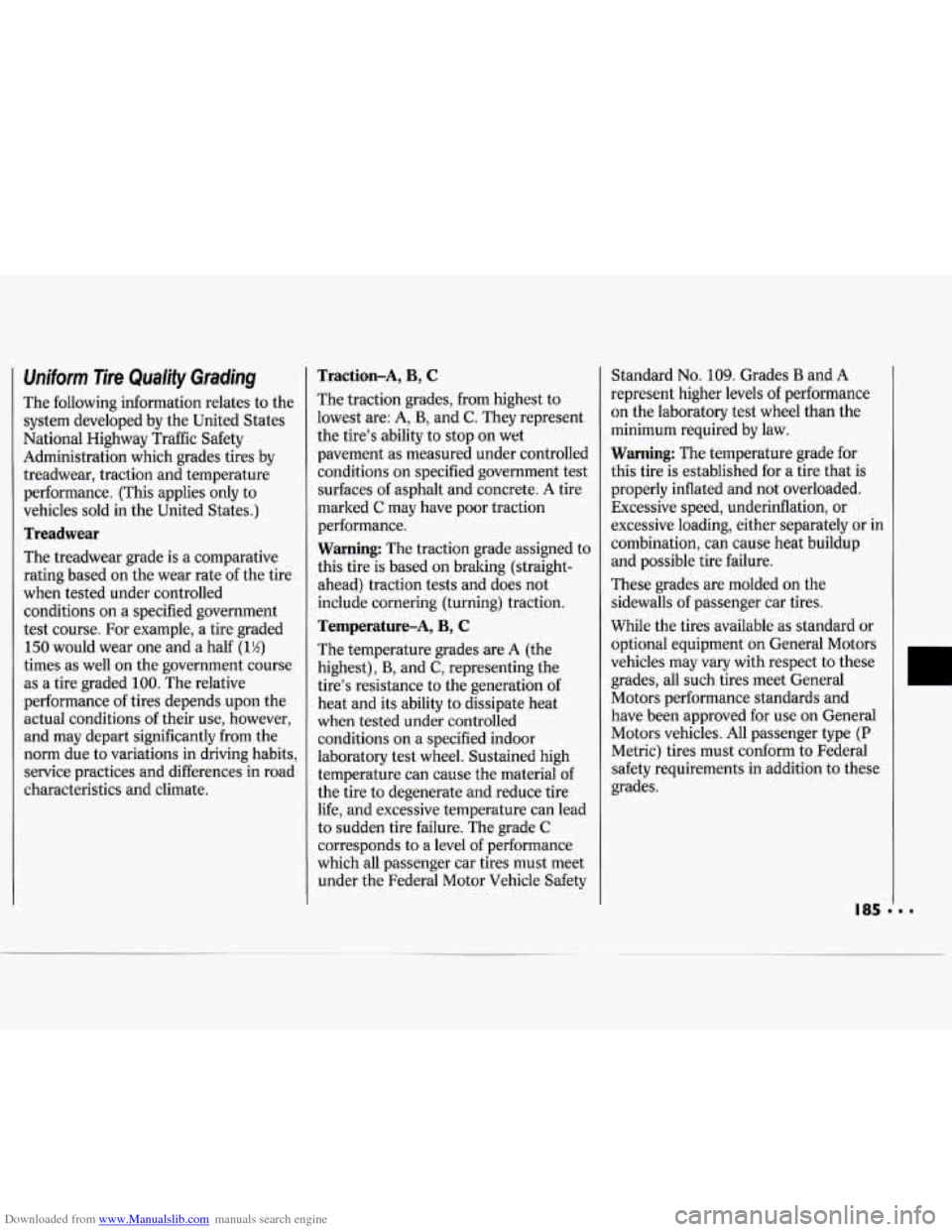
Downloaded from www.Manualslib.com manuals search engine Uniform Tire Qualify Grading
The following information relates to the
system developed by the United States
National Highway Traffic Safety
Administration which grades tires by
treadwear, traction and temperature
performance. (This applies only to
vehicles sold in the United States.)
Treadwear
The treadwear grade is a comparative
rating based on the wear rate
of the tire
when tested under controlled
conditions on a specified government
test course. For example, a tire graded
150 would wear one and a half (1 Yz)
times as well on the government course
as a tire graded
100. The relative
performance of tires depends upon the
actual conditions
of their use, however,
and may depart significantly from the
norm due to variations in driving habits,
service practices and differences in road
characteristics and climate.
Traction-A, B, C
The traction grades, from highest to
lowest are: A,
B, and C. They represent
the tire’s ability to stop on wet
pavement as measured under controlled
conditions on specified government test
surfaces
of asphalt and concrete. A tire
marked
C may have poor traction
performance.
Warning: The traction grade assigned to
this tire
is based on braking (straight-
ahead) traction tests and does not
include cornering (turning) traction.
Temperature-A, B, C
The temperature grades are A (the
highest),
B, and C, representing the
tire’s resistance to the generation
of
heat and its ability to dissipate heat
when tested under controlled conditions on a specified indoor
laboratory test wheel. Sustained high
temperature can cause the material of
the tire to degenerate and reduce tire
life, and excessive temperature can lead
to sudden tire failure. The grade
C
corresponds to a level of performance
which all passenger car tires must meet
under the Federal Motor Vehicle Safety Standard
No.
109. Grades B and A
represent higher levels
of performance
on the laboratory test wheel than the
minimum required by law.
Warning: The temperature grade for
this tire is established for a tire that is
properly inflated and not overloaded.
Excessive speed, underinflation, or
excessive loading, either separately or in
combination, can cause heat buildup
and possible tire failure.
These grades are molded on the
sidewalls of passenger car tires.
While the tires available as standard or
optional equipment
on General Motors
vehicles may vary with respect to these
grades, all such tires meet General
Motors performance standards and
have been approved for use on General
Motors vehicles. All passenger type
(P
Metric) tires must conform to Federal
safety requirements in addition to these
grades.
1
Page 188 of 243
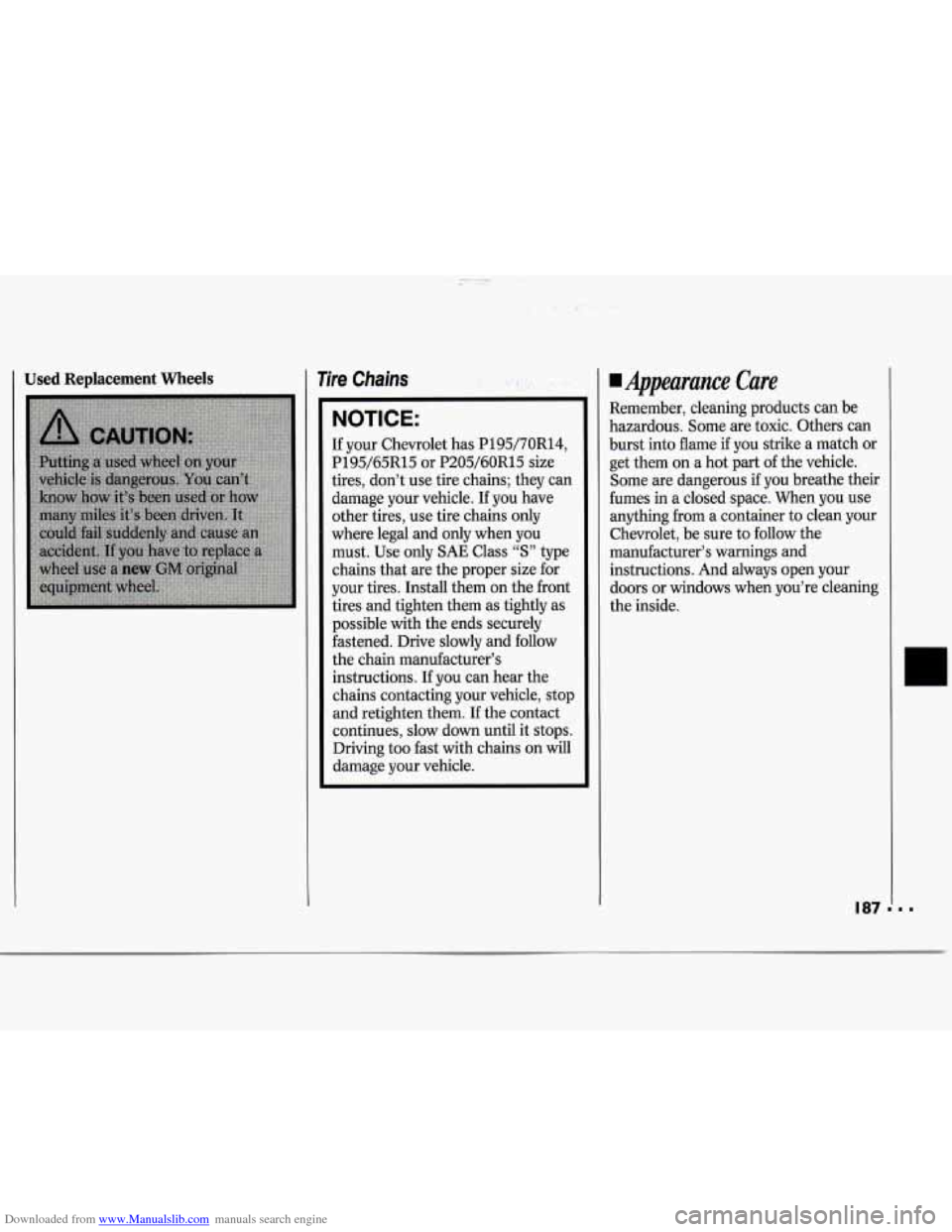
Downloaded from www.Manualslib.com manuals search engine I Used Replacement Wheels Tire Chains . ..
NOTICE:
If your Chevrolet has P195/70R14,
P195/65R15 or P205/60R15 size
tires, don’t use tire chains; they can
damage your vehicle. If you have
other tires, use tire chains only
where legal and only when you
must. Use only
SAE Class “S” type
chains that are the proper size for
your tires. Install them on the front
tires and tighten them as tightly as
possible with the ends securely
fastened. Drive slowly
and follow
the chain manufacturer’s
instructions. If you can hear the
chains contacting your vehicle, stop
and retighten them. If the contact
continues, slow down until it stops.
Driving too fast with chains on will
damage your vehicle.
Uppearance Care
Remember, cleaning products can be
hazardous. Some are toxic. Others can
burst into flame
if you strike a match or
get them on a hot part of the vehicle.
Some are dangerous
if you breathe their
fumes in a closed space. When you use
anything from a container to clean your
Chevrolet, be sure to follow the
manufacturer’s warnings and instructions. And always open your
doors or windows when you’re cleaning
the inside.
I87
Page 193 of 243
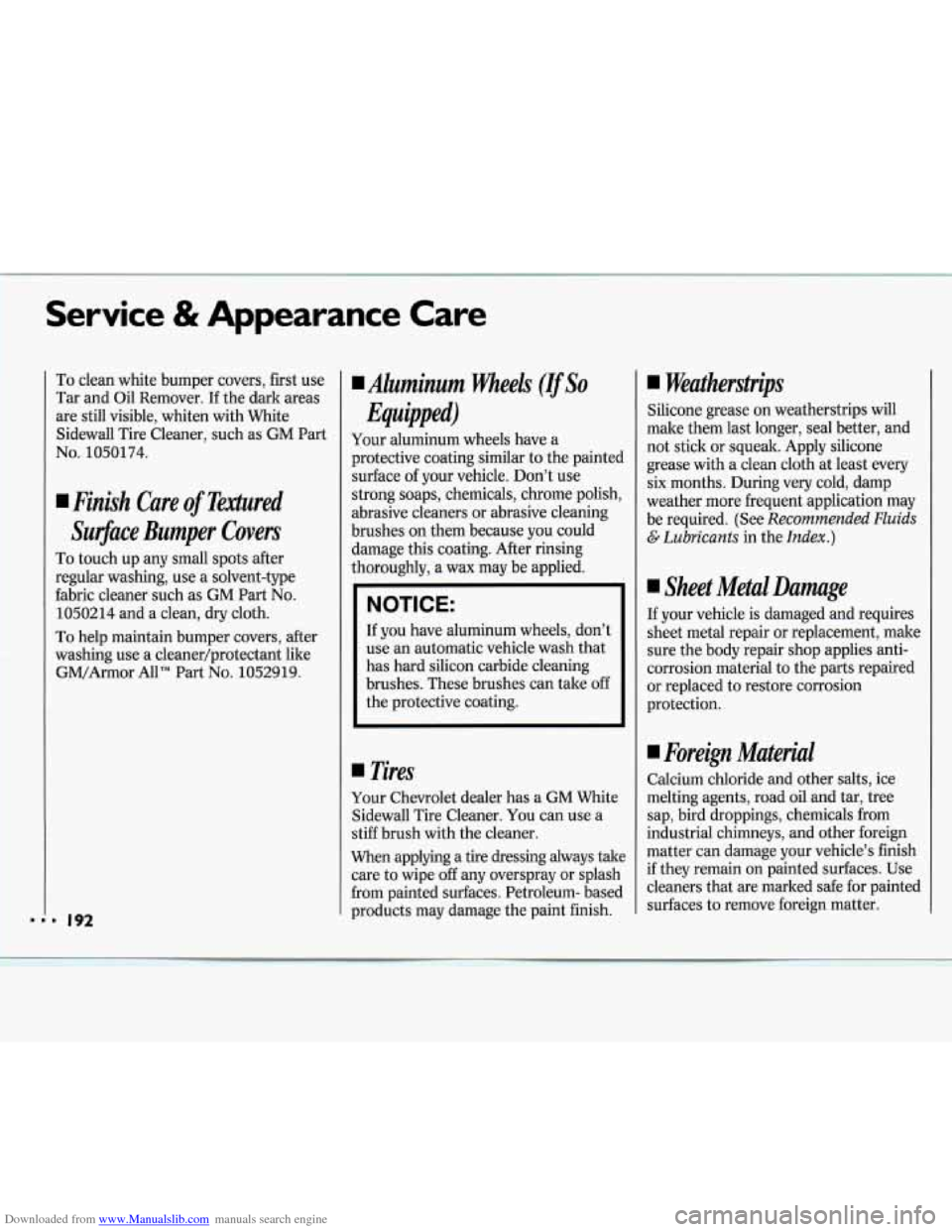
Downloaded from www.Manualslib.com manuals search engine Service & Appearance Care
To clean white bumper covers, first use
Tar and Oil Remover. If the dark areas
are still visible, whiten with White
Sidewall Tire Cleaner, such as GM Part
No. 1050174.
Finish Care of Tdred
SurJace Bumper Covers
To touch up any small spots after
regular washing, use a solvent-type
fabric cleaner such as
GM Part No.
1050214 and a clean, dry cloth.
To help maintain bumper covers, after
washing use a cleaner/protectant like
GM/Armor All" Part
No. 1052919.
I Aluminum wheels (IfSo
Equipped)
Your aluminum wheels have a
protective coating similar to the painted
surface of your vehicle. Don't use
strong soaps, chemicals, chrome polish,
abrasive cleaners or abrasive cleaning
brushes on them because you could
damage this coating. After rinsing
thoroughly, a wax may be applied.
NOTICE:
If you have aluminum wheels, don't
use an automatic vehicle wash that
has hard silicon carbide cleaning
brushes. These brushes can take off
the protective coating.
Tires
Your Chevrolet dealer has a GM White
Sidewall Tire Cleaner. You can use a
stiff brush with the cleaner.
When applying a tire dressing always take
care to wipe
off any overspray or splash
from painted surfaces. Petroleum- based
products may damage the paint finish.
I Weatherstrips
Silicone grease on weatherstrips will
make them last longer, seal better, and
not stick or squeak. Apply silicone
grease with a clean cloth at least every
six months. During very cold, damp
weather more frequent application may
be required. (See
Recommended Fluids
G. Lubricants in the Index.)
Sheet Metal Damage
If your vehicle is damaged and requires
sheet metal repair or replacement, make
sure the body repair shop applies anti-
corrosion material to the parts repaired
or replaced to restore corrosion
protection.
I Foreign Material
Calcium chloride and other salts, ice
melting agents, road oil and tar, tree
sap, bird droppings, chemicals from
industrial chimneys, and other foreign
matter can damage your vehicle's finish
if they remain on painted surfaces. Use
cleaners that are marked safe for painted
surfaces to remove foreign matter.
Page 211 of 243
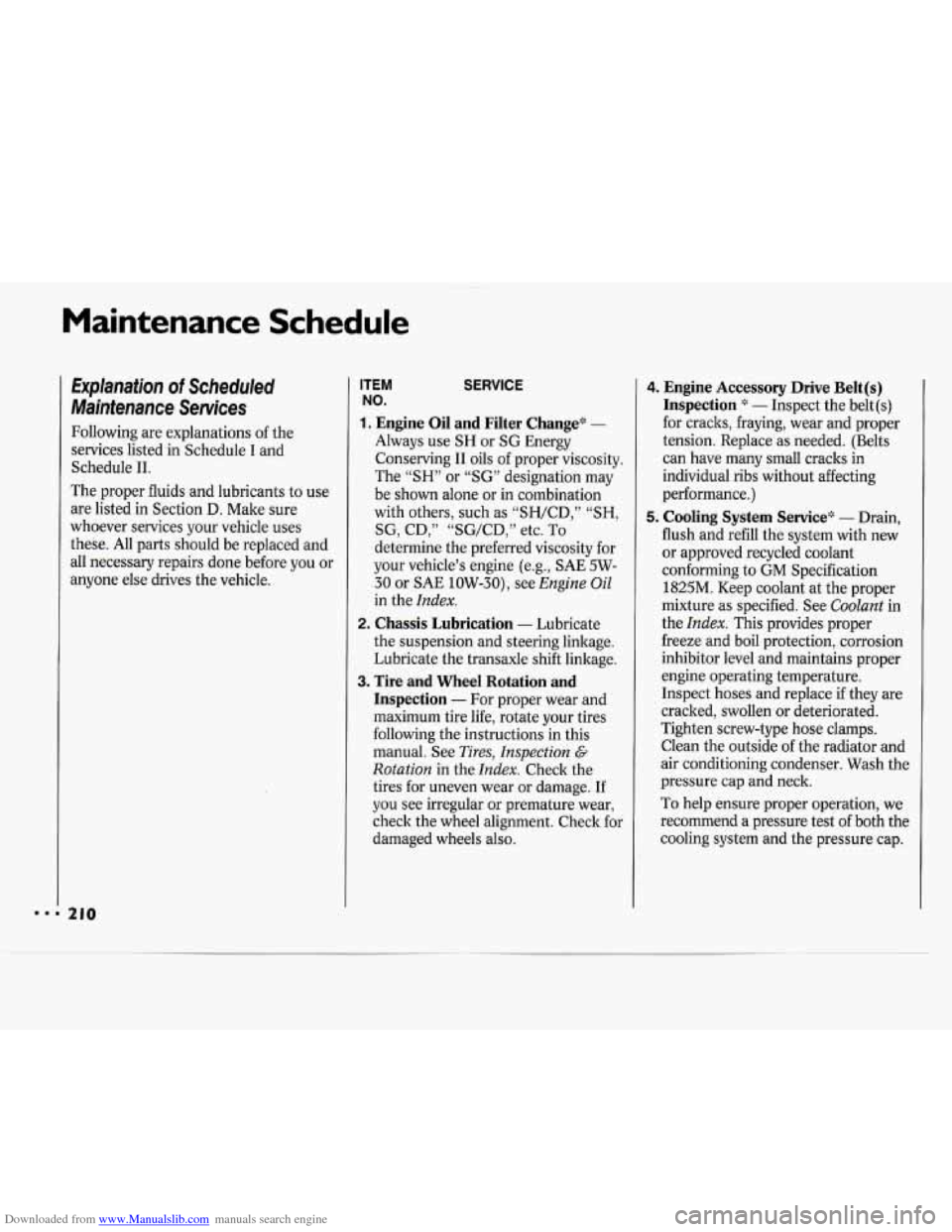
Downloaded from www.Manualslib.com manuals search engine Maintenance Schedule
Explanation of Scheduled
Maintenance Services
Following are explanations of the
services listed in Schedule
I and
Schedule 11.
The proper fluids and lubricants to use
are listed in Section
D. Make sure
whoever services your vehicle uses
these. All parts should be replaced and
all necessary repairs done before you or
anyone else drives the vehicle.
ITEM SERVICE
NO.
1. Engine Oil and Filter Change* -
Always use SH or SG Energy
Conserving I1 oils of proper viscosity.
The
“SH” or “SG” designation may
be shown alone or in combination
with others, such as “SH/CD,”
“SH,
SG, CD,” “SG/CD,” etc. To
determine the preferred viscosity for
your vehicle’s engine (e.g., SAE 5W-
30 or SAE 10W-30), see
Engine Oil
in the Index.
the suspension and steering linkage.
Lubricate the transaxle shift linkage.
Inspection - For proper wear and
maximum tire life, rotate your tires
following the instructions in this
manual. See
Tires, Inspection G
Rotation in the Index. Check the
tires for uneven wear or damage. If
you see irregular or premature wear,
check the wheel alignment. Check for
damaged wheels also.
2. Chassis Lubrication - Lubricate
3. Tire and Wheel Rotation and
4. Engine Accessory Drive Belt(s)
Inspection
* - Inspect the belt (s)
for cracks, fraying, wear and proper
tension. Replace as needed. (Belts
can have many small cracks in
individual ribs without affecting
performance.)
5. Cooling System Service* - Drain,
flush and refill the system with new
or approved recycled coolant
conforming to
GM Specification
1825M. Keep coolant at the proper
mixture as specified. See
Coolant in
the
Index. This provides proper
freeze and boil protection, corrosion
inhibitor level and maintains proper
engine operating temperature.
Inspect hoses and replace if they are
cracked, swollen or deteriorated.
Tighten screw-type hose clamps.
Clean the outside of the radiator and
air conditioning condenser. Wash the
pressure cap and neck.
To help ensure proper operation, we
recommend a pressure test
of both the
cooling system and the pressure cap.
Page 214 of 243
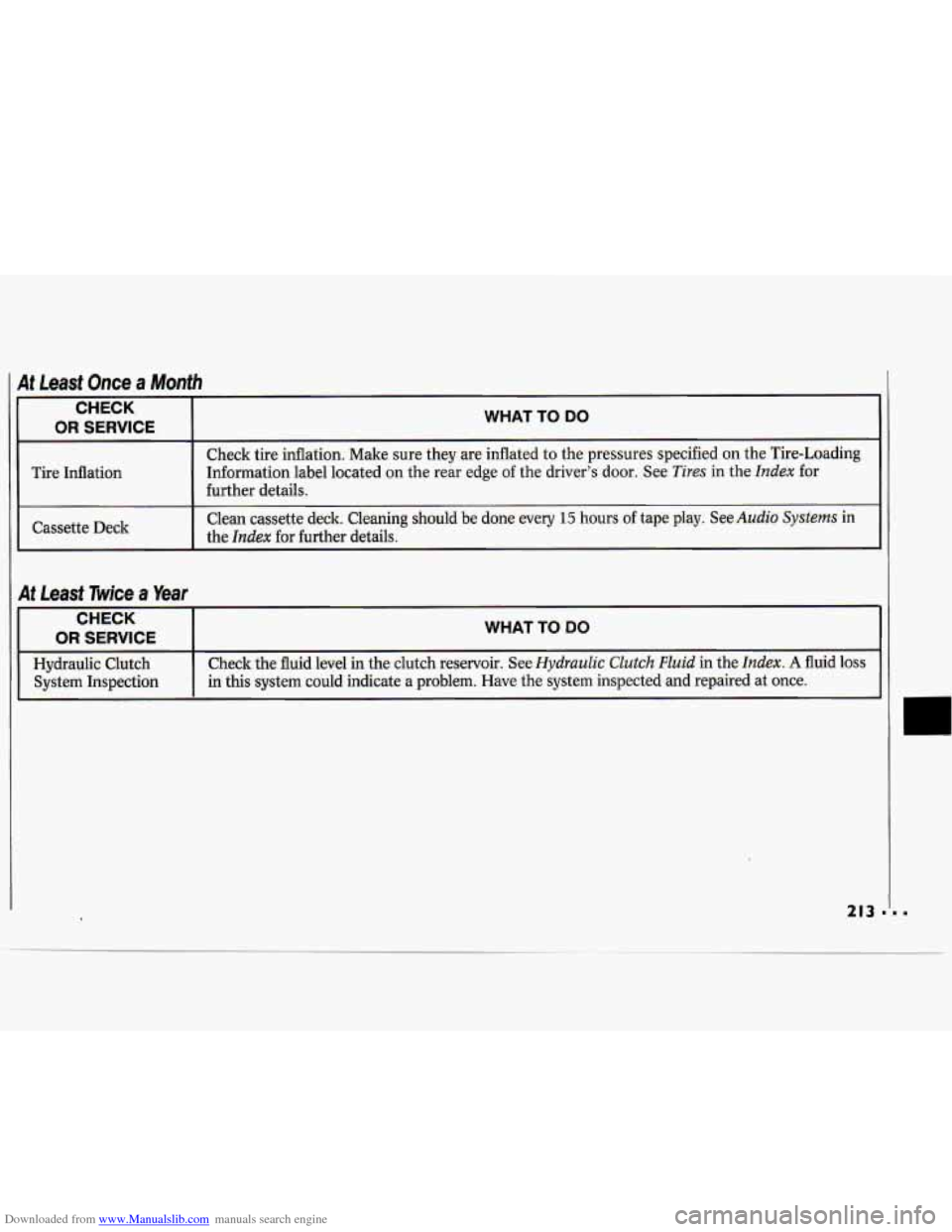
Downloaded from www.Manualslib.com manuals search engine CHECK
OR SERVICE WHAT TO DO
Check tire inflation. Make sure they are inflated to the pressures specified on the Tire-Loading
further details. Clean cassette deck. Cleaning should be done every
15 hours of tape play. See Audio Systems in
the
Index for further details.
Tire Inflation
Information label located on the rear edge of the driver’s door. See
Tires in the Index for
Cassette Deck
At Least Twice a Year
CHECK
OR SERVICE WHAT TO DO
Hydraulic Clutch Check
the fluid level in the clutch reservoir. See Hydraulic CZutch Huid in the Index. A fluid loss
System Inspection in this system could indicate a problem. Have the system inspected and repaired at once.
213 I.
Page 235 of 243
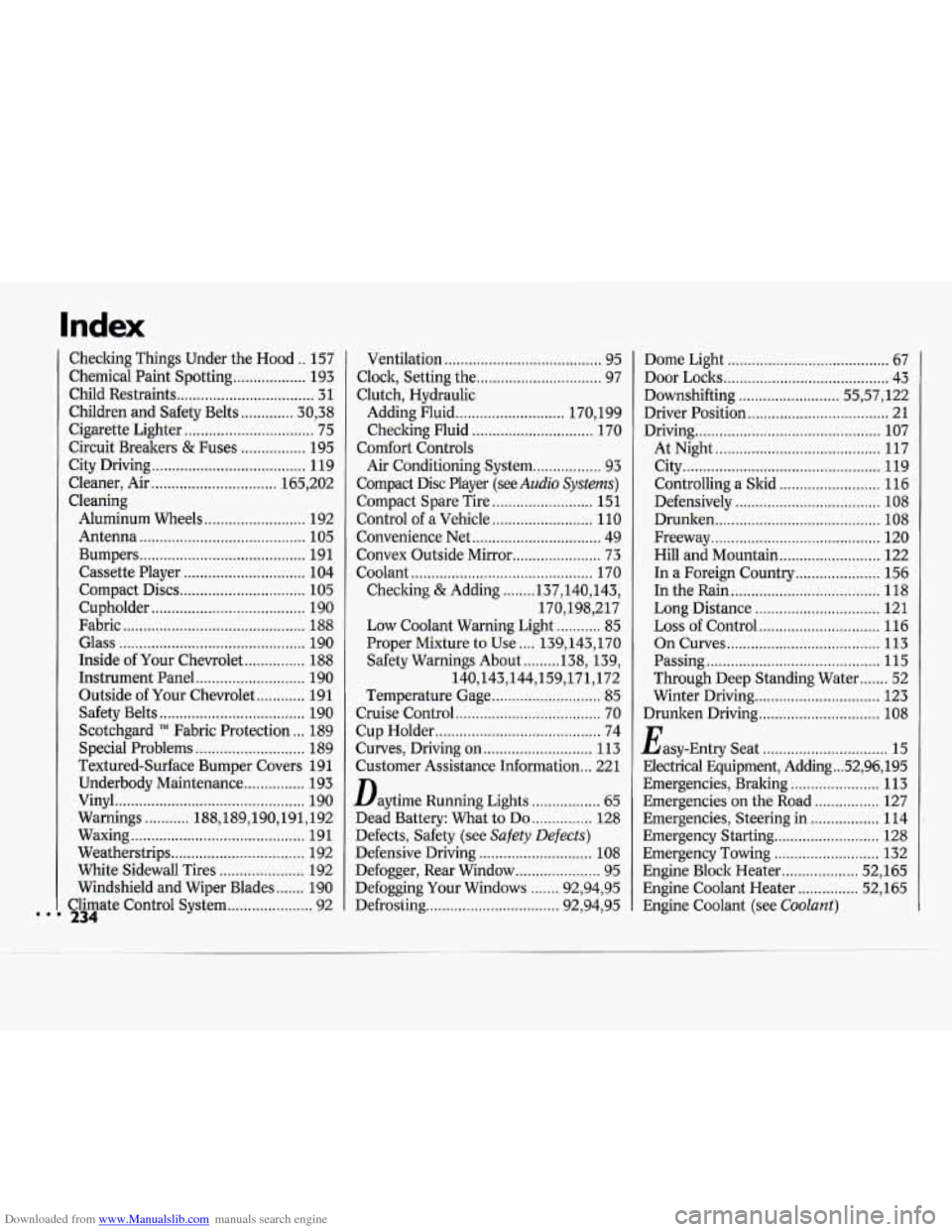
Downloaded from www.Manualslib.com manuals search engine Checking Things Under the Hood .. 157
Child Restraints
.................................. 31
Children and Safety Belts ............. 30. 38
Cigarette Lighter
................................ 75
Circuit Breakers
& Fuses ................ 195
City Driving.,
.................................... 119
Cleaner. Air ............................... 165. 202
Cleaning Chemical
Paint Spotting
.................. 193
Aluminum Wheels
......................... 192
Antenna
......................................... 105
Bumpers
......................................... 191
Cassette Player .............................. 104
Compact Discs
............................... 105
Cupholder
...................................... 190
Fabric
............................................. 188
Glass .............................................. 190
Inside of Your Chevrolet
............... 188
Instrument Panel ........................... 190
Outside of Your Chevrolet
............ 191
Safety Belts
.................................... 190
Scotchgard
TM Fabric Protection ... 189
Textured-Surface Bumper Covers 191
Underbody Maintenance
............... 193
Vinyl
............................................... 190
Warnings
........... 188,189,190,191, 192
Waxing
........................................... 191
Weatherstrips
................................. 192
White Sidewall Tires
..................... 192
Windshield and Wiper Blades
....... 190
Climate Control System
..................... 92
Special Problems
........................... 189
234
Ventilation ....................................... 95
Clock. Setting the
............................... 97
Clutch, Hydraulic Adding Fluid
........................... 170, 199
Checking Fluid
.............................. 170
Comfort Controls
Compact Disc Player (see
Audio Systems)
Compact Spare Tire ......................... 151
Control of
a Vehicle ......................... 110
Convenience Net
................................ 49
Convex Outside Mirror
...................... 73
Coolant
............................................. 170
Checking
& Adding ........ 137,140,143,
170,198, 217
Low Coolant Warning Light ........... 85
Proper Mixture to Use .... 139,143, 170
140,143,144,159,171, 172
Temperature Gage
........................... 85
Cruise Control .................................... 70
Cup Holder
......................................... 74
Customer Assistance Information
... 22 1
Daytime Running Lights ................. 65
Dead Battery: What to Do ............... 128
Defects, Safety (see
Safety Defects)
Defensive Driving ............................ 108
Air Conditioning System
................. 93
Safety Warnings About
......... 138, 139,
Curves, Driving on
........................... 113
Defogger, Rear Window ..................... 95
Defogging Your Windows
...... .92,94, 95
Defrosting
................................. 92,94, 95 Dome Light
........................................ 67
Door Locks
......................................... 43
Downshifting
......................... 55.57. 122
Driver Position
................................... 21
Drnmg 107
At Night
......................................... 117
City
................................................. 119
Controlling a Slid
......................... 116
Defensively
.................................... 108
Drunken
......................................... 108
Freeway
.......................................... 120
Hill and Mountain
......................... 122
In a Foreign Country
..................... 156
In the Rain
..................................... 118
Long Distance ............................... 121
Loss of Control
.............................. 116
On Curves ...................................... 113
Passing ........................................... 115
Through Deep Standing Water ....... 52
Winter Driving
............................... 123
.. ..............................................
..............................
E
Drunken Driving 108
asy-Entry Seat
............................... 15
Electrical Equipment, Adding ... 52,96, 195
Emergencies, Braking
...................... 113
Emergencies on the Road ................ 127
Emergencies, Steering in
................. 114
Emergency Starting
.......................... 128
Emergency Towing
.......................... 132
Engine Block Heater
................... 52, 165
Engine Coolant Heater
............... 52, 165
Engine Coolant (see
Coolant)